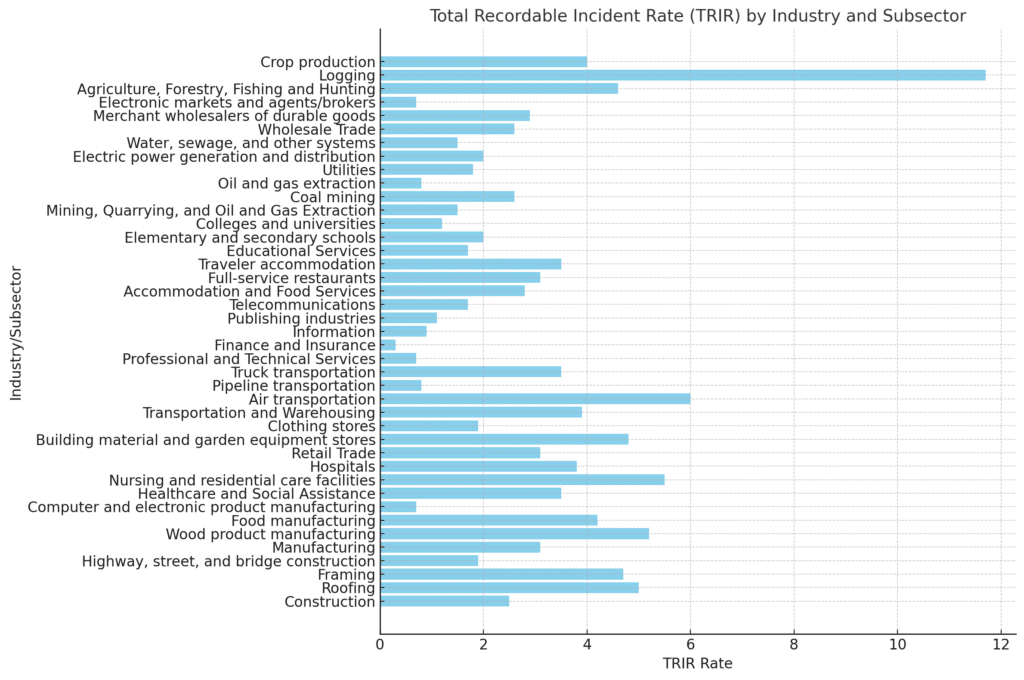OSHA TRIR Calculator – Get Your Injury Incidence Rate

Are you looking to calculate your OSHA Incidence Rate for your work-related injuries? Our Total Recordable Incidence Rate (TRIR) Calculator has you covered. Simply input your total number of recordable injuries for the year and your payroll hours; we will give you your incidence rate!
TRIR Calculator:
TRIR Calculation Inputs:
Total Number of Recordable Injuries:
This is where you will put the number of recordable injuries you had in the previous year. Do not include “near-misses” or non-work-related injuries.
Total Man Hours Per Year:
This is where you will put the total payroll hours you had in the previous year. This is for all employees of your company, including overtime.
What Does Your Incident Rate Say About The Safety Of Your Company?
How many injuries your business has is a direct reflection of your safety program, your work practices, and in the end, the amount you pay for workers’ compensation insurance. But how does your company stack up against its peers? How does your performance this year compare to last year? The only way to know is to “normalize” your injuries using work hours and the number of injuries.
The TRIR calculation above lets you know how you stack up against other companies, regardless of their size versus yours. If you have ten employees and your competitor has 3000, the calculation will still be “fair” because you calculate the number of work injuries per 200,000 man-hours (equivalent to 100 full-time employees). That is how the TRIR calculator works.
The formula used by the Bureau of Labor Statistics to calculate the TRIR, or Total Recordable Incident Rate, is the same for ALL companies:
(The Number of OSHA Recordable Incidents x 200,000) / (Total Number of Hours Worked) = TRIR
Industry-Specific TRIR Standards
It’s important to remember that all industries sustain work-related injuries at different rates. A construction company is going to have more injuries per full-time equivalent FTE worker versus an office-based employer. That means that after you calculate your Total Recordable Incident Rate, you will want to compare your results with statistics from the same industry. To do this, take a look at the data supplied by the BLS. Find your industry, calculate your TRIR, and compare the results. Are you doing better or worse than your industry peers?
What Are Some Industry Averages for Total Recordable Incident Rate (TRIR):

As you can see, several industries have much higher calculations than others. Here is a summary of the chart above:
Industries with High TRIR
Construction (TRIR: 2.5)
- Higher risk subsectors: Roofing (5.0), Framing (4.7)
- Common injuries: Falls, slips, and trips (33%)
- OSHA’s “Focus Four” hazards: Falls, Struck-by, Caught-in/between, Electrocutions
Manufacturing (TRIR: 3.1)
- Higher risk subsectors: Wood product manufacturing (5.2), Food manufacturing (4.2)
- Common injuries: Overexertion and bodily reaction (35%)
- Safety emphasis: Machine guarding and ergonomics
Healthcare and Social Assistance (TRIR: 3.5)
- Higher risk subsectors: Nursing and residential care facilities (5.5), Hospitals (3.8)
- Common injuries: Overexertion from patient handling, needlestick injuries, exposure to bloodborne pathogens
Retail Trade (TRIR: 3.1)
- Higher risk subsectors: Building material and garden equipment stores (4.8)
- Common injuries: Overexertion from lifting, slips, trips, and falls
Transportation and Warehousing (TRIR: 3.9)
- Higher risk subsectors: Air transportation (6.0)
- Common injuries: Vehicle accidents, ergonomic issues from loading/unloading
Agriculture, Forestry, Fishing and Hunting (TRIR: 4.6)
- Higher risk subsectors: Logging (11.7)
- Common hazards: Heavy machinery, animals, pesticide exposure
Industries with Low TRIR
Professional and Technical Services (TRIR: 0.7)
- Common issues: Ergonomic problems from office work, stress, and mental health concerns
Finance and Insurance (TRIR: 0.3)
- Common injuries: Slip, trip, and fall incidents, ergonomic issues
Information (TRIR: 0.9)
- Lower risk subsectors: Telecommunications (1.7)
- Common issues: Ergonomic problems from computer use
Educational Services (TRIR: 1.7)
- Lower risk subsectors: Colleges and universities (1.2)
- Common injuries: Violence from students or others is a growing concern
Mining, Quarrying, and Oil and Gas Extraction (TRIR: 1.5)
- Lower risk subsectors: Oil and gas extraction (0.8)
- Safety emphasis: Preventing catastrophic events like explosions and cave-ins
Utilities (TRIR: 1.8)
- Lower risk subsectors: Water, sewage, and other systems (1.5)
- Common hazards: Electrical hazards and falls
Wholesale Trade (TRIR: 2.6)
- Lower risk subsectors: Electronic markets and agents/brokers (0.7)
- Common incidents: Material handling and transportation
These summaries highlight the significant differences in TRIR rates across various industries and subsectors, emphasizing both high-risk and low-risk areas along with common injury types and safety concerns.
Why You Should Calculate Your TRIR Every Year
The only way to gauge your safety performance and improve from year to year is to calculate your injury rate each and every year. Is your TRIR less than last year? If so, it means you had fewer injuries than the prior year. Is it higher? Then, you know you have some digging to do to find your safety gaps and make improvements for the coming year. Use our TRIR Calculator every year to measure progress and check safety performance. You should also use our DART Rate Calculator and track that information as well.
Where Can I Find My Number of OSHA Recordable Incidents?
Your company should track your work-related injuries so they can fill out the OSHA 300 and 301 forms. Check with your company safety department or human resources office; this information should be available. They should also be able to supply you with your total man hours so that you can get an accurate date for your TRIR calculation.
How To Reduce Your Total Recordable Incidence Rate
There are likely many ways your company can improve its safety record. You should be recording and tracking your “near-misses” so you can try to prevent future accidents. Although they do not go into your TRIR calculation, they are a window into future injuries. You should also have a comprehensive safety training program in place. Finally, constantly let your employees know that your company has a “safety first” mentality and that you need their help to improve workplace safety.
The Importance of Investigating Your Accidents or Injuries:
You should do a detailed investigation for every near-miss, accident, or injury at work. Writing a clear and concise accident report will help you drill down to your root causes. When you know that, you can put processes, procedures, and training in place to prevent future injuries.